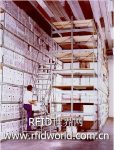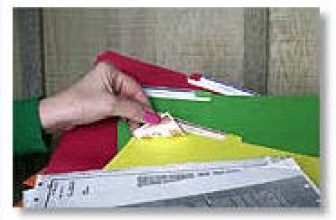
The Human Services Department of San Bernardino, USA adopts RFID system to manage the file library
[ad_1]
The Human Services (HS) department in San Bernardino, California, will use a system that combines RFID and barcode technology to track and locate documents and assets in its warehouses. The HS department plans to start testing this system on September 4 and officially put it into use in January 2008.
The HS Department’s documents record all the citizens in the city who receive food stamps and financial aid and their situation. Expired documents will be sent to a warehouse dedicated to storing documents. Currently, the HS department has a total of 5 document banks in the city, which have stored 1.5 million invalid documents. HS now organizes these documents into a large warehouse, which has 10 rows of 160-foot-long and 19-foot-high shelves.

Human Services (HS) Department File Library in San Bernardino, California, USA
Invalid documents are usually used in state hearings, and HS branches sometimes require these documents. Danny Tillman, HS Information Services Manager, said that manually searching for a document in these piles of documents is very time-consuming. The warehouse clerk searches for files by the number printed on the file box, and the file may be placed in the wrong file box or has been taken away by others, which adds to the difficulty of searching.
In order to speed up file storage and search, the department now uses Digital RFID Asset File System (DRAFT). Lowry Computer Products provides integrated services, hardware and system software, and GlobeRanger provides middleware iMotion Edgeware.
Tillman said that the HS warehouse will be applied to 8 RFID entrance and exit readers, 2 RFID label printing and encoding machines and 6 handheld readers that can read barcodes and RFID tags at the same time. These devices allow HS employees to quickly determine the file box and storage shelf where specific documents are located.
When the expired documents are delivered to the warehouse, the staff arranges every 15 documents in a box, and attaches the box to Lowry Smart’s Trac EPC Gen 2 UHF RFID label, which has an EPC number and a barcode printed on it. Number. The EPC number and barcode number of the label correspond to the name of the file in the box in the HS management system. The file box is then placed on the storage rack. The staff uses a handheld device to obtain the RFID and barcode numbers of the tag, and then scans the label on the storage rack where the file box is located to record the exact location of the file box.
The file box label may include an RFID tag, which may only be printed with a bar code number, and the file box is located by the identification code of the label. Computers and other assets will also be affixed with RFID tags and barcode IDs when they are delivered to the warehouse, and data related to these items are also stored in the HS management system. If these labeled assets leave the warehouse, the reader installed on the warehouse door will obtain the unique ID number of the tag and send the data to the HS SQL database server via an Ethernet cable connection.
Although HS mainly uses RFID technology to identify the file box, “However, label reading errors sometimes occur,” Mendoza explained, “In this case, the barcode scanning function of the handheld can be used to read the label. On the contrary, If a file box is placed on an elevated shelf, the bar scanner will not be able to scan it at this time, and can only use the RFID function of the handheld.
Once the system is officially put into use, office staff from all over the HS can send file calling applications online according to the file box number of each file.
In the warehouse, the management staff will generate a list of documents, sorted according to the location of the documents. The manager takes the found documents from the file box and signs them in the DRAFT system.
The iMotion middleware obtains the ID number of the file box and the asset from the reader, and sends the data to the HS back-end system. Lowry software compiles the data and sends the compiled data to the back-end storage server and front-end Web system, so that warehouse managers can monitor the removal and return of files or assets.
The DRAFT software runs on an HS WEB server. Lowry software will provide HS with a real-time monitoring board based on WBE, showing which documents have not been returned, the documents that need to be reloaded in the box, and the document demand list of the unprocessed HS.
[ad_2]




